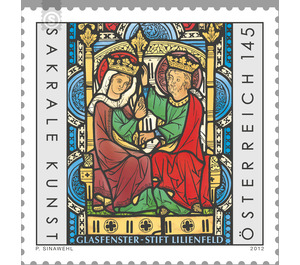Sacred art - Austria / II. Republic of Austria 2012 - 145 Euro Cent
Theme: Art & Culture
| Country | Austria / II. Republic of Austria |
| Issue Date | 2012 |
| Face Value | 145.00 |
| Edition Issued | 270,000 |
| Printing Type | combination printing |
| Stamp Type | Commemorative |
| Item Type | Stamp |
| Chronological Issue Number | 2338 |
| Chronological Chapter | OOS-OE2 |
| SID | 809370 |
| In 53 Wishlists | |
With the present special stamp "Glasfenster - Stift Lilienfeld", the highly acclaimed series "Sacred Art in Austria" now finds its attractive continuation. The aesthetic motif shows the glass window "Marienkrönung" from the early 14th century, in which Christ is represented together with his mother as Queen of Heaven. Sitting on a richly decorated throne, Mary is crowned and receives the lily scepter solemnly. The history of Lilienfeld Abbey: 1202 by Duke Leopold VI. Originally founded, the monastery was originally part of the filiation of the Morimond Primary Abbey (France). In the 14th century the scriptorium of the monastery gained special importance by a certain Abbot Ulrich and his monk Christannus, in the 17th century, the monastery reached the status of a regional center of the Counter-Reformation. From 1641 to 1716, the medieval building complex was supplemented by early Baroque annexes of the guest and west wing, the prelature and the library. During the Turkish siege of Vienna in 1683, the monastery together with the population of the area successfully resisted the looting of the roving Turks and Tartars. Finally, in the first half of the 18th century, the church tower, the library and the interior were built in baroque style. In the time of the Enlightenment, Lilienfeld took on numerous tasks in the pastoral care of many new parishes. In 1789, Emperor Joseph II had the monastery abolished due to the large debts, but his successor, Emperor Leopold II, restored it - also at the request of the local population. During this one year of annulment, many valuable works of art and writings were lost. In 1810, a great fire devastated almost the entire monastery, which in the following years under Abbot Johann Ladislaus Pyrker could only be reconstructed with great difficulty; In 1826, a botanical garden was planted with beautiful exotic plants. In the twentieth century, Stift Lilienfeld suffered from the economic crisis of the 1930s, the severe restrictions imposed during the Nazi regime, and the destructions of the last days of the war; It is allegedly due to only one Russian Bible that the monastery was spared the occupation soldiers of the Soviet Army. In 1976, Pope Paul VI. the collegiate church finally the title of a "basilica minor". Today, Lilienfeld Abbey is still a spiritual and cultural center of the region. It is considered one of the most beautiful monuments of medieval architecture in Austria and is the largest preserved Cistercian monastery in Central Europe.


